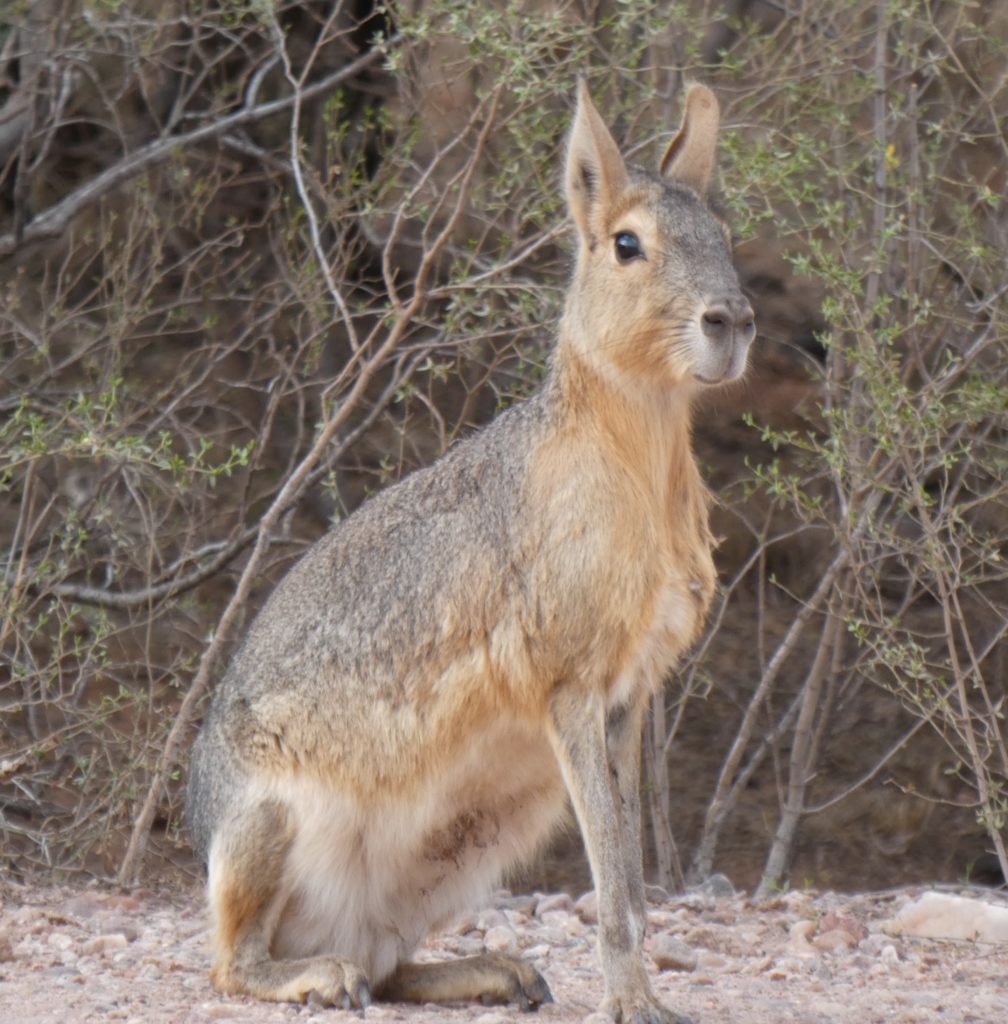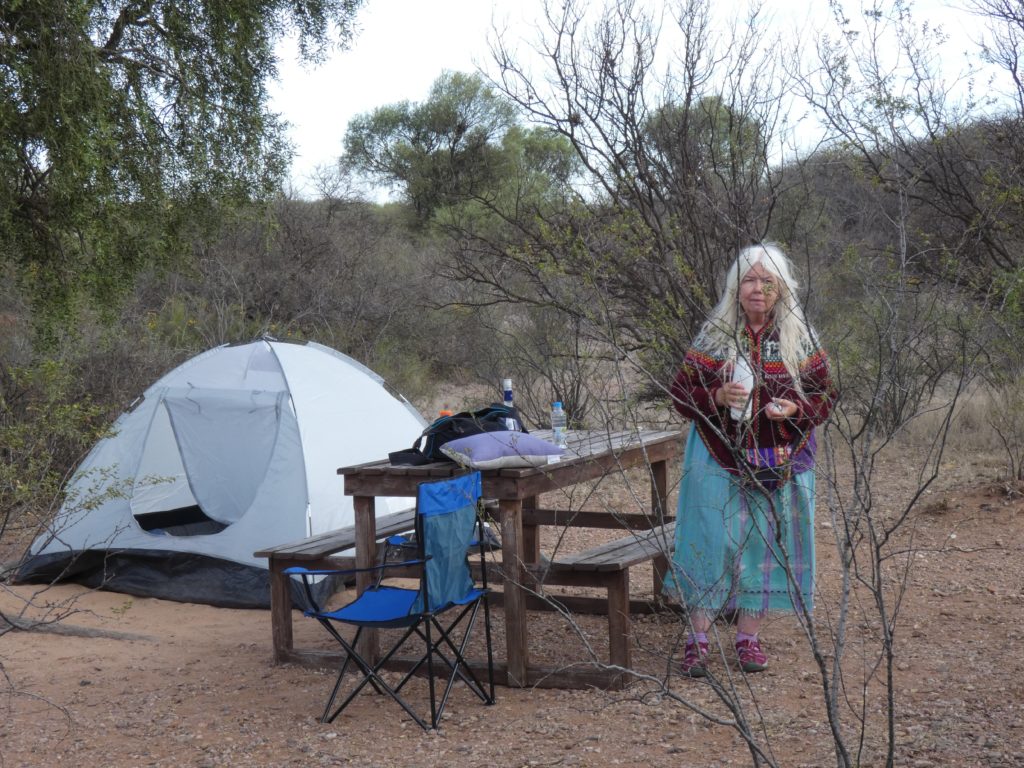Prior post: http://blog.bucksvsbytes.com/2019/11/15/south-america-by-subaru-19-10-29-into-the-wild/
[NOTE: Some displayed images are automatically cropped. Click or tap any photo (above the caption) to see it in full screen.
We pack up camp on a beautiful morning and continue eastward on quiet Argentina Route 20.


We have about 300 miles to go. Our goal is Santa Rosa de Calamuchita for a return visit to Susan’s author friend, Josie Peralta. Like many crossings of central Argentina, we travel on flat, relatively empty land. As usual, we see many goats on and near the pavement. They always look unsupervised but on occasion we see a dog or goatherd off in the brush so I’m sure every herd is watched.

Further down the road, we encounter something distinctly more depressing, especially since we’ve seen it several times in Argentina: a long stretch of highway festooned on both sides by plastic bags hanging off rocks, trees, and fences, tens of thousands of them. In some cases this is the result of garbage illegally dumped along the highway by refuse trucks.In this case, the bags are being blown by wind out of a transfer station. It’s fundamentally ugly and indicates a complete lack of local environmental sensibility.

Another highway feature is going through a dozen or more checkpoints staffed by various police forces. At some of these, the police are nowhere to be seen, sitting in their roadside trailers or fixed posts. I always imagine them relaxing with their cups of mate tea (the Argentine national drink), whiling their time away on cell phones. This may be an unjust characterization, but I’ve directly seen some examples of it. At many others though, police officers stand on the center line, scrutinizing each vehicle as they all slow to a crawl and either waving it through or stopping it for questioning. I have yet to understand what they’re looking for, except at the occasional Fitosanitario stops where they confiscate any produce seen as a threat to local agriculture. Sometimes there will be three checkpoints within 10 miles, each operated by a different force and with no coordination between them.
When we’re stopped the first question is usually “Where are you going?” followed by a request for some car document: drivers license, registration or, very occasionally, proof of insurance. We’re virtually never asked to show passports. At checkpoints, I suddenly can’t speak Spanish. My first response is generally “No hablo mucho español”, carefully enunciated using atrocious English pronunciation. In some cases, we are waved through with a smile. In others, the officer eagerly trots out whatever English proficiency they have. Occasionally, the conversation continues anyway and I have to focus on not absently switching into Spanish. We’ve never been severely hassled, but some drivers are obviously questioned more intensely. At first, I thought our Chile license plates attracted scrutiny, but we’re ignored as often as we’re halted. The “English only”approach is great for routine stops but I’ve learned that for any more complex interaction with the authorities, it’s better to speak Spanish.
Since I can’t understand what all these stops are looking for, I’m tempted to think they are job creation programs, but that’s probably completely unfair. I have to say, though, that having the police stand in the highway at clearly marked checkpoints is much better than the U.S. system where they’re sneaking around or hiding in an effort to catch motorists violating traffic laws and bringing in major revenue that financially supports whole towns. In the U.S., it should be illegal for any jurisdiction to use court imposed fines for budgetary purposes, to eliminate the incentive for ticket mills. Examples of this abuse are periodically the topic of investigative reporting.
In my first three visits to Argentina, there was zero sign of traffic law enforcement. Cars travel way over the speed limit, pass on double yellow lines, and I quickly learned that “Stop” signs and crosswalks are merely aspirational. Even more maddening, most Buenos Aires neighborhood intersections are completely uncontrolled and, even if they have yield signs, right of way is based on how fast and confidently you enter the intersection (I’ve gotten very good at this). Nonetheless, Argentine driving is relatively safe and we see very few accident scenes.
Now, though, certain provinces are introducing roadside radar traps. We’ve seen, perhaps, a half dozen of these over a few thousand miles, using large, old fashioned, tripod-based antennas with the officer standing at the readout (generally in the shade) and radioing ahead to a nearby checkpoint which cars should be ticketed. It’s a primitive approach, so far, but a sign of things to come. I’m sure the radar, lidar, and speed camera vendors are putting on a full court press to get governmental units to buy more sophisticated equipment and have it pay for itself, and more, with fines.
The most troubling aspect of driving here is the ubiquity of motos, low speed motorcycles that move much more slowly than the cars and then weave in, out, and between lanes where traffic is congested. Many drivers and passengers forego helmets and any sort of protective clothing. It’s quite common to see a tee-shirted driver with a female passenger behind wearing shorts and a tank top zipping along at the bike’s top speed of about 50 mph. We met one man who, drunk, slid under an oncoming truck, and two years later is still recovering from major surgery on 3 of his limbs.
About 200 miles into the day’s drive, mountains loom ahead of us. The highway gets more interesting as it winds through picturesque foothill tourist towns and then begins an impressive ascent between and around granite domes to a high, comparatively uninhabited plateau. The road winds north, then east, then south across the range, finally descending to lower elevations dominated by rolling, wooded hills and a large reservoir in the distance.
We arrive in Santa Rosa and look for lodging. On our last visit we stayed with Josie and her adult daughter but now they’ve moved into two tiny adjacent apartments and can no longer accommodate us. As a result, I apply my lodging strategy, which I think is interesting enough to describe here.
I’m not a big Airbnb fan for a number of reasons. First, the only information you have about a property is what they provide in their listing. You have to commit in advance, sight unseen. The lodger pays the Airbnb commission with no assurance that the posted rate is any lower because of it. If the place isn’t to your liking, the effective answer from Airbnb is most likely, “Too bad” unless there’s been some gross misrepresentation.
Almost every lodging in South America is on booking.com and we use it a lot. Approaching an area, I search for rooms there, set filters to eliminate unwanted listings (Susan’s minimum is private bathroom and, in warm weather, air conditioning. I often want a kitchen or included breakfast. We both want wifi and parking.) Once I get the filtered list, I sort from low price to high and work my way down. I want a high booking.com user rating, at least 8 and preferably close to 10. Some you can eliminate immediately by reading the details or user reviews and some don’t have our desired dates available. Susan and I go down the remainder and look at the pictures and written details. More often than not, we find something both economical and very desirable we can agree on — and believe me that’s no small trick. Even then, since booking.com shows the address and often a searchable name, we don’t have to commit ahead of time. Unless it’s late at night, we drive to each lodging in preference order and eyeball it ourselves before taking the room or moving on.
In Santa Rosa, my method came up with about 10 possibilities. We drove to one after the other, rejecting the first 4 for various reasons: room too dark, street too noisy, shabby interior, inadequate wifi in the room, etc. Our 5th possibility, Cabañas Kangarú, was a winner. 2 well appointed cabins to choose from, good kitchen, swimming pool, protected parking, and a very personable young owner couple, Chris and Yanina, an Australian and a Porteña (a Buenos Aires native) and their two young children, Dante and Vera. We immediately seal the deal for 4 nights and unpack. By 6 PM we’re settled in for the evening.
Next post: http://blog.bucksvsbytes.com/2019/11/23/south-america-by-subaru-19-10-31-santa-rosa-de-calamuchita/







